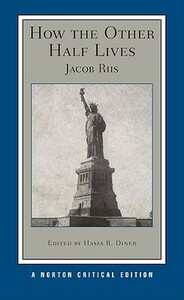You need to sign in or sign up before continuing.
Take a photo of a barcode or cover
It was alright, but it gets really repetitive. Every chapter is the same story, different enclaves.
Read: Introduction 1, Preface, Introduction 2, Chapters 1, 2, 3, 13, 24, and 25.
informative
reflective
slow-paced
dark
informative
reflective
sad
slow-paced
This was a really informative read. Ultimately, though, I didn't find it particularly engaging or enjoyable.
This classic revealed to the world in stark black-and-white photos the lives of the American poor. I learned about Jacob Riis when I took an Urban History course, and was pleased to find a copy of his book in our local library system.
The introduction was interesting--Riis and his entourage (he did not know how to photograph at first) would surprise his subjects by jumping in unexpectedly to their homes. He used a bright light to nearly blind them for the picture-taking. He nearly set a few homes on fire, as well.
The writing style is appropriate for Riis' day, but difficult for modern readers.
This is a must-read book--although not one you'll probably read again.
The introduction was interesting--Riis and his entourage (he did not know how to photograph at first) would surprise his subjects by jumping in unexpectedly to their homes. He used a bright light to nearly blind them for the picture-taking. He nearly set a few homes on fire, as well.
The writing style is appropriate for Riis' day, but difficult for modern readers.
This is a must-read book--although not one you'll probably read again.
Riis uses his photos and narrative to show the well-off people of New York City how some of its occupants live in poverty during the long century. It's commendable that Riis wanted to have a part in the progressive era, but he was still very ignorant and racist. He had something to say about everyone except the poor who were American born.
The narrative is jumbled and I got the feeling that if the people Riis talked about ever found themselves above the poverty line, he would have had something to say about immigrants and African Americans taking wages away from Americans.
The narrative is jumbled and I got the feeling that if the people Riis talked about ever found themselves above the poverty line, he would have had something to say about immigrants and African Americans taking wages away from Americans.
This expose is guided tour through tenements at the end of the 19th century.
It's a difficult book to rate since it is so tied to its time. There are parts (sadly) still applicable today. His summations of the character of different ethnic groups can be a little rough going-it can be wildly prejudice even as he struggles to be fair to those he is writing about. One thing that surprised me was that this was written after the first round of sanitation laws-including the provision that all bedrooms must have a window. I honestly believed this book was part of the reason those laws were written, but it was really a case of the author informing people that what was done was still not enough.
A very clear portrayal of the lives of the poor in turn of the century NYC
A very clear portrayal of the lives of the poor in turn of the century NYC
Finally a book that’s racist towards my ethnicity. And all ethnicities. This book manages to be bigoted towards every single community in New York City while also calling for progressive policies and honestly that’s kind of impressive
A necessary, important book. Great photographs and some details. But also offensive, dated, boring, and difficult. Glad I spent time with it.







